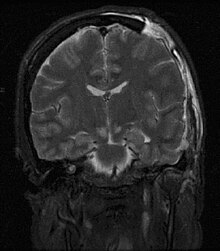
Back ضغط داخل القحف Arabic অন্তঃকরোটি চাপ Bengali/Bangla Pressió intracranial Catalan Intrakranialt tryk Danish Hirndruck German Presión intracraneal Spanish فشار درونجمجمهای Persian Kallonsisäinen paine Finnish Hypertension intracrânienne French לחץ תוך-גולגולתי HE
| Intracranial pressure | |
|---|---|
 | |
| Severely high ICP can cause the brain to herniate. | |
| Types | Increased, normal, decreased |
Intracranial pressure (ICP) is the pressure exerted by fluids such as cerebrospinal fluid (CSF) inside the skull and on the brain tissue. ICP is measured in millimeters of mercury (mmHg) and at rest, is normally 7–15 mmHg for a supine adult.[1] The body has various mechanisms by which it keeps the ICP stable, with CSF pressures varying by about 1 mmHg in normal adults through shifts in production and absorption of CSF.
Changes in ICP are attributed to volume changes in one or more of the constituents contained in the cranium. CSF pressure has been shown to be influenced by abrupt changes in intrathoracic pressure during coughing (which is induced by contraction of the diaphragm and abdominal wall muscles, the latter of which also increases intra-abdominal pressure), the valsalva maneuver, and communication with the vasculature (venous and arterial systems).
Intracranial hypertension (IH), also called increased ICP (IICP) or raised intracranial pressure (RICP), is elevation of the pressure in the cranium. ICP is normally 7–15 mm Hg; at 20–25 mm Hg, the upper limit of normal, treatment to reduce ICP may be needed.[2]
- ^ Steiner LA, Andrews PJ (July 2006). "Monitoring the injured brain: ICP and CBF". British Journal of Anaesthesia. 97 (1): 26–38. doi:10.1093/bja/ael110. PMID 16698860.
- ^ Ghajar J (September 2000). "Traumatic brain injury". Lancet. 356 (9233): 923–929. doi:10.1016/S0140-6736(00)02689-1. PMID 11036909. S2CID 45288155.
© MMXXIII Rich X Search. We shall prevail. All rights reserved. Rich X Search